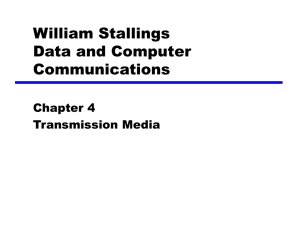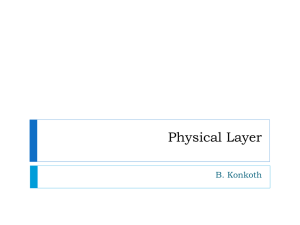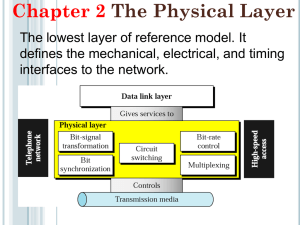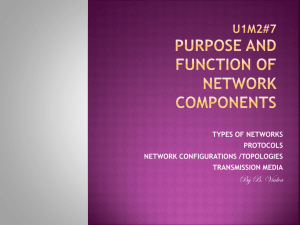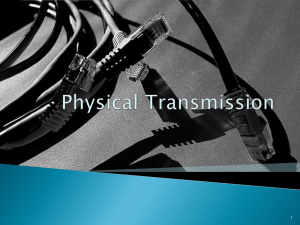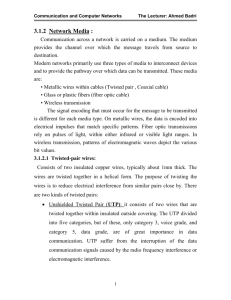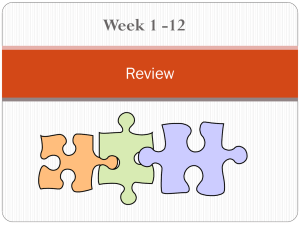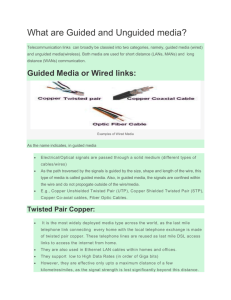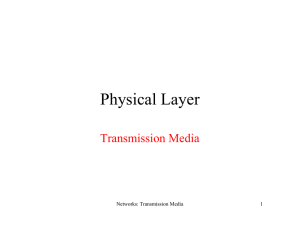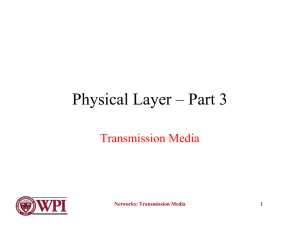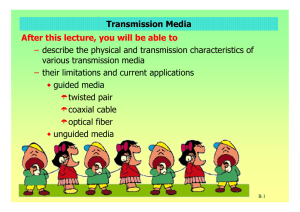William Stallings Data and Computer Communications
advertisement
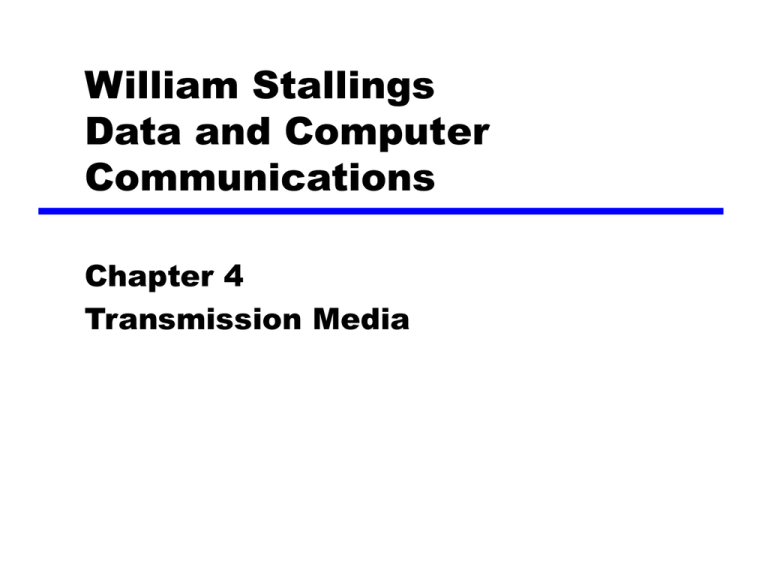
William Stallings Data and Computer Communications Chapter 4 Transmission Media Overview Guided - wire Unguided - wireless Characteristics and quality determined by medium and signal For guided, the medium is more important For unguided, the bandwidth produced by the antenna is more important Key concerns are data rate and distance Design Factors Bandwidth Higher bandwidth gives higher data rate Transmission impairments Attenuation Interference Number of receivers In guided media More receivers (multi-point) introduce more attenuation Electromagnetic Spectrum Guided Transmission Media Twisted Pair Coaxial cable Optical fiber Twisted Pair Twisted Pair - Applications Most common medium Telephone network Between house and local exchange (subscriber loop) Within buildings To private branch exchange (PBX) For local area networks (LAN) 10Mbps or 100Mbps Twisted Pair - Pros and Cons Cheap Easy to work with Low data rate Short range Twisted Pair - Transmission Characteristics Analog Amplifiers every 5km to 6km Digital Use either analog or digital signals repeater every 2km or 3km Limited distance Limited bandwidth (1MHz) Limited data rate (100MHz) Susceptible to interference and noise Unshielded and Shielded TP Unshielded Twisted Pair (UTP) Ordinary telephone wire Cheapest Easiest to install Suffers from external EM interference Shielded Twisted Pair (STP) Metal braid or sheathing that reduces interference More expensive Harder to handle (thick, heavy) UTP Categories Cat 3 up to 16MHz Voice grade found in most offices Twist length of 7.5 cm to 10 cm Cat 4 up to 20 MHz Cat 5 up to 100MHz Commonly pre-installed in new office buildings Twist length 0.6 cm to 0.85 cm Near End Crosstalk Coupling of signal from one pair to another Coupling takes place when transmit signal entering the link couples back to receiving pair i.e. near transmitted signal is picked up by near receiving pair Coaxial Cable Coaxial Cable Applications Most versatile medium Television distribution Ariel to TV Cable TV Long distance telephone transmission Can carry 10,000 voice calls simultaneously Being replaced by fiber optic Short distance computer systems links Local area networks Coaxial Cable - Transmission Characteristics Analog Amplifiers every few km Closer if higher frequency Up to 500MHz Digital Repeater every 1km Closer for higher data rates Optical Fiber Optical Fiber - Benefits Greater capacity Data rates of hundreds of Gbps Smaller size & weight Lower attenuation Electromagnetic isolation Greater repeater spacing 10s of km at least Optical Fiber - Applications Long-haul trunks Metropolitan trunks Rural exchange trunks Subscriber loops LANs Optical Fiber - Transmission Characteristics Act as wave guide for 1014 to 1015 Hz Portions of infrared and visible spectrum Light Emitting Diode (LED) Cheaper Wider operating temp range Last longer Injection Laser Diode (ILD) More efficient Greater data rate Wavelength Division Multiplexing Optical Fiber Transmission Modes Wireless Transmission Unguided media Transmission and reception via antenna Directional Focused beam Careful alignment required Omnidirectional Signal spreads in all directions Can be received by many antennae Frequencies 2GHz to 40GHz Microwave Highly directional Point to point Satellite 30MHz to 1GHz Omnidirectional Broadcast radio 3 x 1011 to 2 x 1014 Infrared Local Terrestrial Microwave Parabolic dish Focused beam Line of sight Long haul telecommunications Higher frequencies give higher data rates Satellite Microwave Satellite is relay station Satellite receives on one frequency, amplifies or repeats signal and transmits on another frequency Requires geo-stationary orbit Height of 35,784km Television Long distance telephone Private business networks Broadcast Radio Omnidirectional FM radio UHF and VHF television Line of sight Suffers from multipath interference Reflections Infrared Modulate noncoherent infrared light Line of sight (or reflection) Blocked by walls e.g. TV remote control, IRD port Required Reading Stallings Chapter 4
